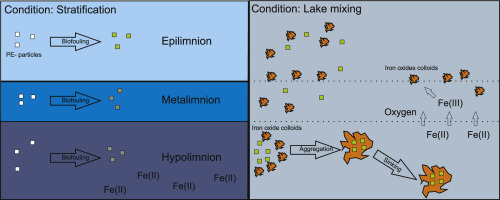当前位置:
X-MOL 学术
›
Water Res.
›
论文详情
Our official English website, www.x-mol.net, welcomes your
feedback! (Note: you will need to create a separate account there.)
Biofouling, metal sorption and aggregation are related to sinking of microplastics in a stratified reservoir.
Water Research ( IF 11.4 ) Pub Date : 2020-03-25 , DOI: 10.1016/j.watres.2020.115748 Rico Leiser 1 , Gi-Mick Wu 2 , Thomas R Neu 3 , Katrin Wendt-Potthoff 1
Water Research ( IF 11.4 ) Pub Date : 2020-03-25 , DOI: 10.1016/j.watres.2020.115748 Rico Leiser 1 , Gi-Mick Wu 2 , Thomas R Neu 3 , Katrin Wendt-Potthoff 1
Affiliation

|
Microplastic particles entering aquatic systems are rapidly colonized by microbial biofilms. The presence of microbial biomass may cause sinking of particles and as a consequence prevent their transport to the oceans. We studied microbial colonization of different polymer particles exposed in the epi-, meta- and hypolimnion of a freshwater reservoir during late summer for 47 days. Parameters measured included biofilm formation, metal sorption and sinking velocities. Microbial biofilms contained bacteria, cyanobacteria and algae as well as inorganic particles such as iron oxides. Regardless of biofilm thickness and biovolumes of different biofilm constituents, single polyethylene (PE) particles stayed buoyant, whereas the sinking velocity of single polystyrene (PS) and polyethylene terephthalate (PET) particles did not change significantly compared to initial values. During exposition, a mixing event occurred, by which anoxic, iron-rich water from the hypolimnion was mixed with water from upper layers. This induced aggregation and sinking of hypolimnetic PE particles together with organic matter, cyanobacteria colonies and iron minerals.
中文翻译:

生物污垢,金属吸附和聚集与分层储层中的微塑料下沉有关。
进入水生系统的微生物微粒被微生物生物膜迅速定殖。微生物生物量的存在可能会导致颗粒下沉,从而阻止其向海洋的运输。我们研究了夏末47天暴露在淡水水库的上,下和下倾角中的不同聚合物颗粒的微生物定殖。测量的参数包括生物膜形成,金属吸附和下沉速度。微生物生物膜包含细菌,蓝细菌和藻类以及诸如氧化铁的无机颗粒。无论生物膜的厚度和不同生物膜成分的生物体积如何,单个聚乙烯(PE)颗粒都能保持漂浮状态,而单个聚苯乙烯(PS)和聚对苯二甲酸乙二醇酯(PET)颗粒的沉降速度与初始值相比没有明显变化。在暴露过程中,发生了混合事件,通过该事件,来自次小lim虫的缺氧富铁水与来自上层的水混合。这会引起低速PE颗粒以及有机物,蓝细菌菌落和铁矿物质的聚集和下沉。
更新日期:2020-03-26
中文翻译:

生物污垢,金属吸附和聚集与分层储层中的微塑料下沉有关。
进入水生系统的微生物微粒被微生物生物膜迅速定殖。微生物生物量的存在可能会导致颗粒下沉,从而阻止其向海洋的运输。我们研究了夏末47天暴露在淡水水库的上,下和下倾角中的不同聚合物颗粒的微生物定殖。测量的参数包括生物膜形成,金属吸附和下沉速度。微生物生物膜包含细菌,蓝细菌和藻类以及诸如氧化铁的无机颗粒。无论生物膜的厚度和不同生物膜成分的生物体积如何,单个聚乙烯(PE)颗粒都能保持漂浮状态,而单个聚苯乙烯(PS)和聚对苯二甲酸乙二醇酯(PET)颗粒的沉降速度与初始值相比没有明显变化。在暴露过程中,发生了混合事件,通过该事件,来自次小lim虫的缺氧富铁水与来自上层的水混合。这会引起低速PE颗粒以及有机物,蓝细菌菌落和铁矿物质的聚集和下沉。









































 京公网安备 11010802027423号
京公网安备 11010802027423号